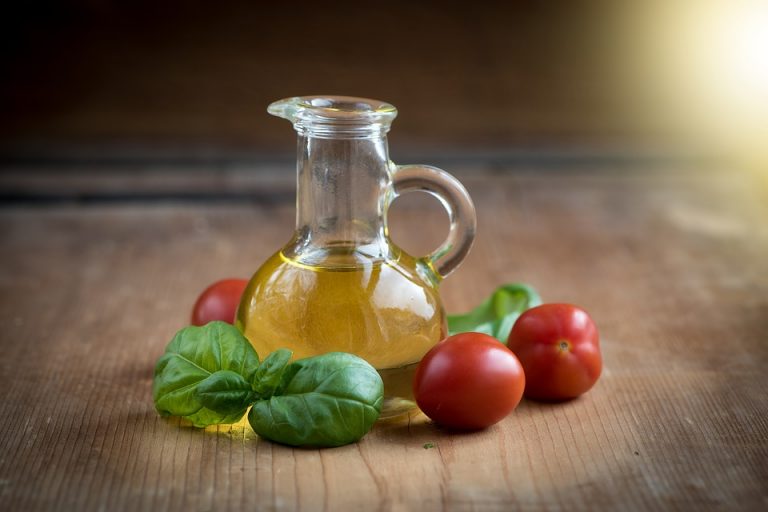What should we use for frying? Sunflower oil, rapeseed oil, olive oil, or maybe coconut oil or lard?
Frying in high temperatures, within 180°C changes the molecular structure of fat, which reacts with oxygen from the air, forming lipid peroxides and aldehydes. This oxidation also occurs in room temperature, just slower.
Consuming aldehydes with food or breathing them in while frying increases the risk of heart diseases and cancer, it’s therefore worth making sure to limit their formation.
Smoke (temperature) point
The overall rule is that the higher smoke point, the better the oil is for frying. Oils with smoke points lower than 200°C are unsuitable for deep frying.
The smoking point is temperature at which the fat starts to constantly smoke. This smoke indicates the chemical breakdown of fat into glycerol and free fatty acids. Glycerol is then decomposed into acrolein (having carcinogenic properties), which is one of the main ingredients of the bluish smoke.
Position of the smoke point highly depends on the free fatty acid content, and less on of partial glycerides. The influence of the degree of unsaturation is minimal, but the chain length has a significant effect. Oils that contain short chain fatty acids (e.g. lauric acid), have a lower smoking point than oils with predominantly longer chained fatty acids.
Emission of aldehydes during frying
In a spanish study from 2009, four most popular oils were checked.
Fats smoking temperature:
- Coconut oil - 175°C
- Extra virgin olive oil - 195°C
- Sunflower oil - 212°C
- Rape - 238°C
Composition of various fats:
- Coconut oil (91% saturated fatty acids)
- Olive Extra virgin olive oil (72% monounsaturated fatty acids)
- oil (75% of polyunsaturated fatty acids)
- Rapeseed oil (58% monounsaturated, 38% polyunsaturated fatty acids)
Oils were heated to four different temperatures: 180, 210, 240 and 270°C for 6 hours (samples were taken every hour).
Emissions of volatile aldehydes from all four oil increased gradually with temperature, until it reached the smoking point. From that moment, the emissions increased rapidly.
As it seems, temperature of the oil used for frying shouldn’t exceed that smoking point, otherwise the emission of harmful substances will increase drastically. Because of this, coconut oil should not be used for deep frying, as its smoking point is (175°C) is lower than the optimal frying temperature (180°C). However, even below the critical point the emission of acrolein and acetaldehyde can be harmful in kitchens with limited ventilation.
Acrolein forms from glycerin in temperatures above 240°C, but in the studies, it already appeared at 180°C, which means, that there is a path of its formation even in relatively small temperatures.
How did the oils behave while frying?
Scientists attributed the emission of acrolein the most important thing, due to its carcinogenic nature.
In temperature around 180°C, the emission of acrolein was the lowest, and coconut oil as well as olive oil secreted a lot less of it than the other oils. At around 240°C, the emission increased dramatically, especially when it came to rapeseed oil, and around 270°C, there was a massive increase of its emission from sunflower oil, and secondly - from coconut oil.
Sunflower oil emitted the most 2-heptenal and 2-Hexanon in all temperatures. Olive oil emitted significantly more 2-decenal and nonanal, but starting only at around 210°C.
Paradoxically, contrary to the general principle, it’s fat with the lowest smoking point: coconut oil, that turned out to emit the least aldehydes and other volatile compounds. Its harmfulness increased drastically at around 270°C, which is very close to this fats burning point (275-280°C)
Scientists warn from warming up used oil again - no matter what kind, as the “used” oilcontains a lot more free fatty acids, and in consequence, its smoking point drastically decreases, resulting in higher emission of volatile compounds at lower temperatures.
What frying oil should you choose?
Professor of analytical chemistry and chemical pathology, Martin Grootveld from De Montfort University explains in the pages of the BBC, that oils rich in unsaturated fats, such as sunflower or corn oil, emit the most aldehydes while frying.
Professor Grootveld recommends olive oil for frying, which he calls the “ideal compromise”:
“(...) because it consists of 76% monounsaturated acids, 14% of the saturated fatty acid and only in 10% of polyunsaturated fatty acids - saturated and monounsaturated fatty acids are much more resistant to oxidation than the polyunsaturated fatty acids”.
[The composition of olive oil provided by Grootveld differs a little from the composition provided by the Spanish scientists - which is a common occurrence, when scientists refer to the results of various studies].
Grootveld claims, that it doesn’t matter whether you use the extra virgin olive oil or not:
“The level of antioxidants present in the extra virgin products is not sufficient to protect us from temperature-induced oxidation.”
Studies conducted by him suggest, that frying on saturated animal fats is healthier than frying on sunflower oil.
The professor declares:
“If I had to choose between lard and polyunsaturated fats, I would choose lard every time.”







One Comment